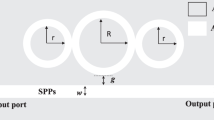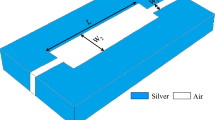Abstract
In this paper, we propose a design for surface plasmon polariton band gap (SPPBG)-enabled plasmonic Mach–Zehnder interferometer (PMZI) comprising of array of silver nanorods embedded upright into silicon on insulator (SOI) substrate and analyze its potential in sensing, intended for cancer therapy. Periodic arrangement of nanorods embedded into SOI substrate grants strong spatial confinement and assist waveguidance to the propagating plasmon mode due to the SPPBG effect. This arrayed system triggers local field enhancement promoting sensing proficiency of the device and is assessed in terms of wavelength and phase shift. Proposed design of SPPBG-enabled PMZI sensor is successfully employed for detection and classification of various cancerous cells. The structural parameters of PMZI are optimized in compliance with the plasmonic band gap in the range of 400–800 nm yielding exceptionally high sensitivity at input wavelength of 633 nm. Volumetric analysis of the analyte reveals that very small analyte volume of the order of 10−15 cc is sufficient to yield significant phase shift. Phase shift obtained for the breast adenocarcinoma and blood cancer cell lines are 1.2357radian and 0.3351radian, respectively, which read very high value of phase shifts to identify extremely small changes in refractive index of the analyte. Figure of merit calculated thereby expose impressive device performance outdoing preceding plasmonic sensors leading to validation of proposed ultra-compact-sensitive PMZI design.








Similar content being viewed by others
References
Bozhevolnyi SI, Boltasseva A, Sondergaard T, Nikolajsen T, Leosson K (2005) Opt Commun 250:328
Kim DS, Hohng SC, Malyarchuk V, Yoon YC, Ahn YH, Yee KJ, Park JW, Kim J, Park Q, Lienau C (2003) PRL 91:143901
Bozhevolnyi SI, Erland J, Leosson K, Skovgaard PMW, Hvam JM (2001) PRL 86:3008
Mekis A, Chen JC, Kurland I, Fan S, Villeneuve PR, Joannopoulos JD (1996) PRL 77:3787
Barnes WL, Dereux A, Ebbesen TW (2003) Nature 424:824
Wu SY, Ho HP, Law WC, Lin C (2004) Opt Lett 29:2378
Gao Y, Gan Q, Xin Z, Cheng X, Bartoli FJ (2011) ACS Nano 5:9836
Drezet A, Hohenau A, Stepanov AL, Ditlbacher H, Steinberger B, Aussenegg FR, Leitner A, Krenn JR (2006) Plasmonics 1:141
Thomas R, Ikonic Z, Kelsall RK (2012) PNFA 10:183
Bozhevolnyi SI, Volkov VS, Devaux E, Laluet JY, Ebbesen TW (2006) Nature 440:508
Wahsheh RA, Lu Z, Abushagur MAG (2009) Opt Commun 282:4622
Pu M, Yao N, Hu C, Xin X, Zhao Z, Wang C, Luo X (2010) Opt Express 18:21030
Guo X, Qiu M, Bao J, Wiley BJ, Yang Q, Zhang X, Ma Y, Yu H, Tong L (2009) Nano Lett 9:4515
Xia Y, Halas NJ (2005) MRS Bull 30:338
Lal S, Link S, Halas NJ (2007) Nat Photonics 1:641
Choi WJ, Jeon DI, Ahn SG, Yoon JH, Kim S, Lee BH (2011) Opt Express 18:23285
Zysk AM, Chaney EJ, Boppart SA (2006) Phys Med Biol 51:2165
Liang XJ, Liu AQ, Lim CS, Ayi TC, Yap PH (2007) Sens Act A 133:349
Kosmeier S, Kemper B, Langehanenberg P, Bredebusch I, Schnekenburger J, Bauwens A, Bally GV (2008) Proc SPIE 6991:6999110
Loo C, Lin A, Hirsch L, Lee MH, Barton J, Halas NJ, West J, Drezek R (2004) Tech Cancer Res Treat 3:33
Hagness SC, Taflove A, Bridges JE (1999) IEEE Trans Ant Prop 47:783
Zhang G, Long M, Wu ZZ, Yu WQ (2002) World J Gastroenterol 8:243
Suresh S (2007) Acta Biomater 3:413
Lekka M, Laidler P, Gil D, Lekki J, Stachura Z, Hrynkiewicz AZ (1999) Eur Biophys J 28:312
Guck J, Schinkinger S, Lincoln B, Wottawah F, Ebert S, Romeyke M, Lenz D, Erickson HM, Ananthakrishnan R, Mitchell D, Kas J, Ulvick S, Bilby C (2005) Biophys J 88:3689
Katira P, Zaman MH, Bonnecaze RT (2012) Phys Rev Lett 108:028103
Reticker-Flynn NE, Malta DFB, Winslow MM, Lamar JM, Xu MJ, Underhill GH, Hynes RO, Jacks TE, Bhatia SN (2012) Nat Commun 3:1122
Lin AWH, Lewinski LA, West JL, Halas NJ, Drezek RA (2005) J Biomed Opt 10:064035
El-Sayed IH, Huang X, El-Sayed MA (2005) Nano Lett 5:829
Agarwal A, Huang SW, O’Donnell M, Day KC, Day M, Kotov N, Ashkenazi S (2007) J Appl Phys 102:064701
Mallidi S, Larson T, Tam J, Joshi PP, Karpiouk A, Sokolov K, Emelianov S (2009) Nano Lett 9:2825
Skrabalak SE, Au L, Lu X, Li X, Xia Y (2007) Nanomedicine 2:657
Ladd J, Lu H, Taylor AD, Goodell V, Disis ML, Jiang S (2009) Colloids Surf B: Biointerfaces 70:1
Backman V, Wallace MB, Perelman LT, Arendt JT, Gurjar R, Müller MG, Zhang QZonios G, Kline E, McGillican T, Shapshay S, Valdez T, Badizadegan K, Krawford JM, Fitzmaurice M, Kabani S, Levin HS, Seiler M, Dasari RR, Itzkan I, Dam JV, Feld MS (2000) Nature 406:35
Barer R (1957) J Opt Soc Am 47:545
Song WZ, Zhang XM, Liu AQ, Lim CS, Yap PH, Hosseini HMM (2006) Appl Phys Lett 89:203901
Lue N, Popescu G, Ikeda T, Dasari RR, Badizadegan K, Feld MS (2006) Opt Lett 31:2759
Chin LK, Liu AQ, Lim CS, Zhang XM, Ng JH, Hao JZ, Takahashi S (2007) Appl Phys Lett 91:243901
Liang W, Huang Y, Xu Y, Lee RK, Yariv A (2005) Appl Phys Lett 86:151122
Homola J (2003) Anal Bioanal Chem 377:528
Anker JN, Hall WP, Lyandres O, Shah NC, Zhao J, Duyne RPV (2008) Nat Mater 7:442
Dillu V, Sinha RK (2013) Indian Patent Application No. 1168/DEL/2013 CBR No. 3985
Gan Q, Gao Y, Bartoli FJ (2009) Opt Express 17:20747
Johnson PB, Christy RW (1972) Phys Rev B 6:4370
Dillu V, Shruti, Srivastava T, Sinha RK (2013) Physica E 48:75
Rajput M, Sinha RK (2010) Appl Phys B 98:99
Mayer KM, Hafner JH (2011) Chem Rev 111:3828
Acknowledgments
The authors greatly acknowledge the initiative and support towards establishment of “TIFAC-Center of Relevance and Excellence in Fiber Optics and Optical Communication at Delhi College of Engineering now Delhi Technological University, Delhi, through Mission Reach Program of Technology Vision 2020, Government of India. Also, we would like to extend our acknowledgement to Dr Anurag Mehta and Mr Sujeet Nath Sinha of Rajiv Gandhi Cancer Institute and Research Center for allowing us to use their resources and carry out the research work in regard of cancer cell lines.
Author information
Authors and Affiliations
Corresponding author
Rights and permissions
About this article
Cite this article
Dillu, V., Sinha, R.K. Surface Plasmon Polariton Band Gap-Enabled Plasmonic Mach–Zehnder Interferometer: Design, Analysis, and Application. Plasmonics 9, 527–535 (2014). https://doi.org/10.1007/s11468-013-9652-5
Received:
Accepted:
Published:
Issue Date:
DOI: https://doi.org/10.1007/s11468-013-9652-5




